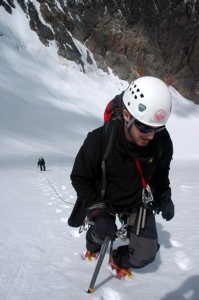 Mosquitoes can walk on water as well as any waterbug, or stick to a wall like Spiderman. Now Chinese bioengineers are figuring out what makes them such versatile pests.
Mosquitoes can walk on water as well as any waterbug, or stick to a wall like Spiderman. Now Chinese bioengineers are figuring out what makes them such versatile pests.
A team led by C. W. Wu at the Dalian University of Technology in China mounted a mosquito‘s leg on a needle and pushed it down onto a tub of water on a digital balance. By varying the angle, they found that a single leg could hold 23 times a mosquito‘s weight before becoming submerged, they report in July’s Physical Review Letters.
Scanning electron microscope images revealed that the insect’s legs are equipped with tiny scales, each with up to a dozen longitudinal ridges connected by fine transverse ribs. The scientists speculated that air trapped between the ribs may form “nanocushions” that contribute to buoyancy, but their experiments also indicated the importance of the angle of the leg in not breaking through the surface. As the authors note, mosquitoes are equally at home on dry land. It turns out that their feet are equipped with tiny hooks and covered in adhesive hairs similar to those on a fly.
Mathematician David Hu of New York University notes that understanding water-repellent nanostructures will be useful for anyone who wants to make an all-terrain robotic insect. “If it’s ever going to fly in the rain, water repellency is going to be important.”
Originally appeared in Science Magazine as a Random Sample: [html] [pdf]
 A wood-burning stove that uses sound to generate electricity and refrigeration could one day make waves in developing countries. That’s the hope of an international team headed by engineer Paul Riley of the University of Nottingham in the United Kingdom. This month, the U.K. government and the U.S.’s Los Alamos National Laboratory in New Mexico awarded the team almost $4 million to develop a Stove for Cooking, Refrigeration, and Electricity (SCORE). The appliance would rely on external combustion, such as a wood fire, to heat one end of a tube of compressed gas, inducing sound waves that can be harnessed to generate enough electricity to power a light bulb and a small refrigeration unit.
A wood-burning stove that uses sound to generate electricity and refrigeration could one day make waves in developing countries. That’s the hope of an international team headed by engineer Paul Riley of the University of Nottingham in the United Kingdom. This month, the U.K. government and the U.S.’s Los Alamos National Laboratory in New Mexico awarded the team almost $4 million to develop a Stove for Cooking, Refrigeration, and Electricity (SCORE). The appliance would rely on external combustion, such as a wood fire, to heat one end of a tube of compressed gas, inducing sound waves that can be harnessed to generate enough electricity to power a light bulb and a small refrigeration unit.

